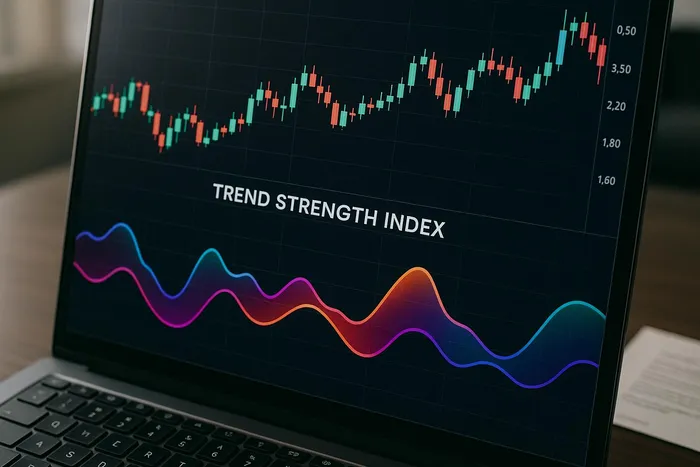Explore how the Trend Strength Index (TSI) helps traders assess market trends and improve trading decisions with actionable insights.
The True Strength Index (TSI) is a momentum indicator that helps traders evaluate the strength and direction of market trends. Using a double-smoothing technique, it filters out short-term price fluctuations, making it easier to identify genuine trend shifts. TSI values revolve around a zero line, with positive readings indicating bullish momentum and negative readings signaling bearish momentum. Key tools include zero-line crossovers, signal line crossovers, and divergences, all of which help traders spot trend changes, reversals, or continuations.
Key Takeaways:
- Zero-line crossovers: Positive crossovers suggest bullish trends; negative crossovers indicate bearish trends.
- Signal line crossovers: Useful for timing trades within ongoing trends.
- Divergences: Highlight potential reversals or trend continuations by comparing price action with TSI movements.
- Adjustable parameters: Shorter periods increase sensitivity but risk false signals, while longer periods provide smoother, more reliable trends.
LuxAlgo provides trading tools on TradingView and an AI platform for backtesting. These help you automate signal detection, validate ideas, and configure real-time alerts for informed decisions.
Trend Strength Index (TSI): Tutorial
How the Trend Strength Index Works
The True Strength Index (TSI) is a momentum oscillator that revolves around a central zero line, making it easier to spot shifts in market momentum. By transforming price data into an easy-to-read format, the TSI helps determine whether bullish or bearish forces are dominating.
Reading TSI Values
Understanding TSI readings can provide valuable insights into market trends:
- Positive values above zero indicate growing upward momentum, signaling a bullish market sentiment.
- Negative values below zero point to increased selling pressure, reflecting bearish momentum.
- Extremely high values might suggest an overbought condition, where a correction could be imminent; very low values may highlight oversold conditions. Learn more about these concepts in this guide to overbought and oversold signals.
One of the most important signals is the zero-line crossover. When the TSI moves from negative to positive, it suggests a bullish trend is emerging. Conversely, a shift from positive to negative indicates bearish momentum is taking hold. The farther the TSI moves from zero, the stronger the trend it represents.
Calculating the Trend Strength Index
To truly grasp the TSI, it's essential to understand how raw price data is transformed into this refined momentum oscillator. The step-by-step process sheds light on how the TSI responds to market activity and why tweaking its parameters can significantly alter its behavior.
Step-by-Step Calculation Process
The calculation begins by determining price momentum. This involves finding the difference between consecutive closing prices, which gives the raw price change for each period.
Next comes the double smoothing process using exponential moving averages (EMAs). First, the price changes are smoothed with an EMA over a longer period, typically 25 periods. Then, a second EMA (usually over 13 periods) is applied to further refine the momentum data. (If you need a refresher, see what an Exponential Moving Average is and how it’s calculated.) This double smoothing creates the numerator, representing the smoothed momentum.
For the denominator, the same double smoothing process is applied, but this time to the absolute values of the price changes. This step captures the total absolute price movement.
Finally, the smoothed momentum is divided by the smoothed absolute momentum, and the result is multiplied by 100. This normalization typically keeps TSI values in a bounded range that’s easy to compare across securities and timeframes.
How Parameters Affect TSI Performance
The TSI relies on two key parameters: the fast period and the slow period, which influence how the indicator reacts to price changes. The slow period (first smoothing) is typically set to 25 periods, while the fast period (second smoothing) is usually 13 periods.
- Shorter parameters make the TSI more sensitive, producing more frequent signals. For example, reducing the slow period from 25 to 15 results in quicker reactions to trend shifts. However, this increased sensitivity can lead to more false signals, especially in sideways markets.
- Longer parameters create smoother signals, filtering out short-term market noise. Extending the slow period to 35 or 40 reduces signal frequency but may improve reliability. The downside is that signals may lag, causing traders to enter trends later than ideal.
| Parameter Setting | Signal Frequency | Noise Level | Best Market Conditions |
|---|---|---|---|
| Fast (10, 20) | High | High | Clear, trending markets |
| Standard (13, 25) | Medium | Medium | Most market conditions |
| Slow (20, 40) | Low | Low | Volatile or choppy markets |
A balanced approach often involves maintaining a 1:2 ratio, such as 13:25, which works well across various market conditions. When the ratio becomes too narrow, like 15:20, the double smoothing effect weakens.
Experienced traders often tailor TSI parameters to match volatility. For instance, high-volatility assets like cryptocurrencies may benefit from longer smoothing periods to reduce false signals. More stable instruments, such as major forex pairs, might perform better with standard or shorter parameters for quicker signal generation.
Using TSI Signals for Trading Decisions
The TSI isn't just about identifying trends; it also helps traders fine-tune entries and exits. By highlighting shifts in momentum and potential reversals, the TSI offers a more refined approach compared to basic momentum oscillators. Its double-smoothed design filters out noise, making it easier to spot clear signals.
Using Signal Line and Zero Crossovers
One of the simplest ways to use the TSI is by looking at crossovers—when the indicator moves above or below key reference points. These crossovers confirm momentum changes and identify trend direction.
- Zero line crossovers are significant. When the TSI crosses above zero, it signals increasing bullish momentum; crossing below zero indicates growing bearish momentum.
- Signal line crossovers occur more frequently and help time trades within existing trends. The signal line is typically an EMA of the TSI. For instance, in an uptrend, waiting for the TSI to cross back above the signal line after a pullback can confirm that upward momentum is resuming.
The reliability of these crossovers often depends on where they occur. Crossovers near extreme TSI levels can carry more weight than those close to zero.
Beyond crossovers, divergences between the TSI and price action offer deeper insights into market sentiment and potential trend weaknesses. If you’re new to the concept, here’s a concise explainer on divergence in technical analysis.
Spotting Divergences with Price Action
While crossovers highlight momentum changes, divergences uncover subtle shifts in market sentiment. These occur when price action and the TSI move in opposite directions, signaling underlying changes that may not yet be apparent in price alone.
- Bullish divergence happens when price makes lower lows, but the TSI forms higher lows—bearish momentum is weakening.
- Bearish divergence occurs when price makes higher highs, but the TSI forms lower highs—bullish momentum is fading.
- Hidden divergences point to trend continuation rather than reversals.
To trade divergences effectively, confirmation is key. Look for additional validation from price action, such as a break of a key level, or a reversal candlestick pattern. Divergences are often more reliable on higher timeframes, where they carry greater significance.
Using LuxAlgo Tools for TSI Analysis
Grasping TSI signals is a key part of trading, and LuxAlgo helps by automating signal detection and strategy validation. LuxAlgo provides advanced indicators on TradingView and an AI Backtesting platform to streamline analysis and execution.
Oscillator Matrix for Real-Time TSI Insights
LuxAlgo builds on TSI basics by combining multiple indicators into a single, user-friendly dashboard. The Oscillator Matrix centralizes momentum tools and visually highlights crucial signals.
Automated divergence detection marks patterns on your chart with clear visuals showing both strength and direction. You also get money flow insights to complement TSI readings.
The Matrix excels at identifying trend-following confluence—moments when multiple momentum indicators align. See the confluence documentation for details and examples.
AI Backtesting Assistant for Strategy Testing
Manually testing TSI-based strategies across markets can take weeks. LuxAlgo’s AI Backtesting Assistant lets you evaluate performance across assets and timeframes in minutes. It helps with strategy optimization (testing parameter combinations) and multi-timeframe analysis, and uncovers how TSI signals interact with volatility and volume.
Once optimal settings are determined, results can inform your live workflow. Configure alerts so you never miss a key TSI signal.
Custom Alerts and Live Market Updates
Tracking TSI signals across markets is easier with well-structured alerts. Setting up alerts through TradingView is straightforward. Options include thresholds and conditions specific to TSI-style signals. The "Any Alert() Function Call" option can monitor multiple conditions at once (typically on bar close).
For clarity, create custom alert messages using placeholders like {{close}} (close), {{interval}} (timeframe), or {{plot("Name")}} (specific values). Example: “AAPL 1H: TSI crossed above signal line at $150.25—bullish momentum confirmed.”
Advanced logic can require conditions to occur in sequence—e.g., oversold → signal-line cross → zero-line break—before a notification fires.
Conclusion: Using the Trend Strength Index with LuxAlgo
The TSI is a powerful way to gauge market momentum via a double-smoothed calculation that balances clarity and responsiveness.
To get the most out of TSI, pair it with sound risk management and complementary tools. LuxAlgo’s Oscillator Matrix simplifies divergence detection and highlights confluence, while the AI Backtesting Assistant helps fine-tune parameters to adapt to market conditions. For structure, you can also incorporate tools such as the Market Structure Oscillator or Support & Resistance Dynamic alongside Signals & Overlays on TradingView.
FAQs
How can traders use the Trend Strength Index (TSI) to improve their trading strategies?
Traders use the True Strength Index (TSI) to assess momentum and trend strength, helping identify possible reversals or confirm ongoing trends. Many combine TSI with other technical indicators to validate signals and fine-tune entries and exits.
What are the risks of using shorter or longer TSI parameter settings, and how can traders handle them effectively?
Shorter smoothing makes TSI more reactive (and prone to whipsaws); longer smoothing can delay signals. To navigate this, backtest different settings and pair TSI with structural tools such as support and resistance levels or trendlines to validate signals.
How does LuxAlgo make the Trend Strength Index (TSI) more effective for real-time trading?
LuxAlgo elevates TSI-style analysis by combining it with AI-powered tools and real-time market analysis. These help track trends, spot structural shifts, and manage live conditions so you can act decisively.
References
LuxAlgo Resources
- Adaptive Momentum Oscillator
- Candlestick Trading Secrets
- How to Trade Reversals using LuxAlgo Tools
- Price Action Concepts™
- Signals & Overlays – Alerts
- Market Sentiment Technicals
- Trending Market Toolkit
- Triangular Momentum Oscillator & Real-Time Divergences
- Reversal Candlestick Structure
- Oscillator Matrix™
- Oscillator Matrix – Confluence
- AI Backtesting Assistant
- Market Structure Oscillator
- Support & Resistance Dynamic
- Signals & Overlays™








